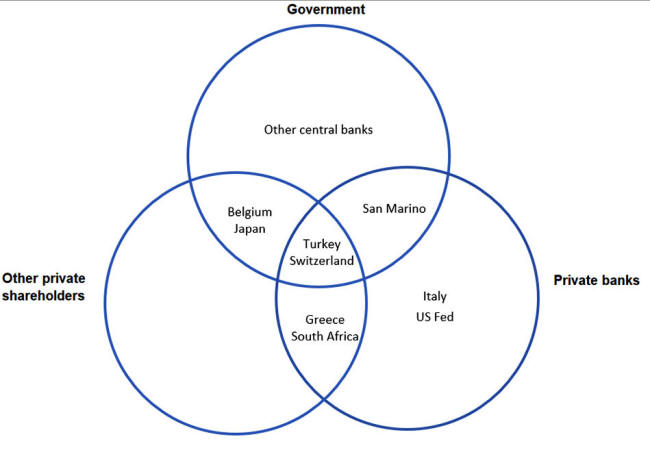|
by David Bholat and Karla Martinez Gutierrez October 18, 2019 from BankUnderground Website
But do these differences
matter?
Ownership implies
control...
The owners of corporations (shareholders) are usually abstracted from their day-to-day operations. Instead, control of corporate resources is ordinarily exercised by its management.
Therefore, to say that I own shares in a corporation has a much narrower meaning than when I say I own a bike.
In the case of a
corporation, I am mainly saying that I have a financial interest in
the business, specifically, that I am a
residual claimant on the
corporation's profits after all other claimants such as employees,
creditors and the government (taxes) have been paid.
While both modern central banks and modern corporations are often characterized by a separation between ownership and control, there are key differences in their organizational objectives.
Consequently, the issue of central bank ownership is considered by most scholars of marginal importance.
Yet the issue of central bank ownership is a salient topic to revisit at present when the constitutional basis of central banks is receiving renewed attention (Goodhart and Lastra 2017; Tucker 2018).
In what follows, we offer
a survey of the variety of central bank ownership structures
historically and globally.
That changed mid-century...
Some established central banks, like the Bank of England, were nationalized (Figure 2). At the same time, almost all of the central banks created in post-colonial states were established fully state-owned.
By the end of the
century, just a handful of central banks with private sector
shareholders remained.
Ownership model of central banks
globally over time, 1900 to the present
List of nationalized central banks globally
in order of year nationalized
These include central banks in,
Figure 3 classifies these central banks according to whether they are owned by government, private sector banks, other private sector shareholders, or some combination of these.
The European Central Bank (ECB) represents a fourth ownership model not adequately captured by Figure 3, as it is established by treaty among EU member states.
Besides the ECB, other supra-national central banks include,
Classification of central banks by ownership
and information from central banks' websites
Ownership models vary considerably among these nine central banks.
Institutional detail on central banks
not fully owned by governments
In some cases, like the US Federal Reserve (FED), the amount paid to shareholders is fixed such that the dividend closely resembles a coupon payment on a bond.
In other cases, as in Turkey, the remuneration is variable and discretionary, although even here it is capped.
A recent paper (No
Smoking Gun - Private shareholders, Governance rules, and Central
Bank financial Behavior) finds that central banks with
private sector shareholders do not differ from central banks with
only public sector shareholders either in their profitability or in
the share of profits they distribute to shareholders.
Occasionally, some people argue central banks should be fully privatized, with the largest private sector banks playing the role of lenders of last resort. Conversely, some argue central banks should be fully nationalized.
However, central bank ownership on its own may not matter. Instead, the crucial factors may be other aspects of their governance, especially their mission statements.
Today, all central banks, whether wholly owned by government or with shares held by private sector entities, have mandates based on economy-wide outcomes.
A truly private sector
central bank without implicit or explicit government guarantees, and
which singularly pursued profits for its shareholders, would likely
behave differently from current central banks, which take their
objective to be the promotion of the 'public good'...
We conclude by suggesting two areas for future research.
Year-on-year changes in the value of the National Bank of Belgium's stock and
the BEL
20 stock market index (r = .706)
Researchers could study whether there is any correlation between central bank ownership structure and these macroeconomic outcomes.
For example, Figure 6 plots the number of years that OECD and G20 countries have experienced financial crises between 1970 and 2017.
Countries are split between those with fully state-owned central banks, and those that have central banks with some form of private sector shareholding.
The median value (8 years in a financial crisis) is the same for both countries with fully-state owned central banks, and those that have central banks with some form of private sector shareholding over this time period.
There is thus no clear
association between financial stability and central bank ownership
structure, although we would like to see deeper empirical work to
draw firmer conclusions.
Number of years between 1970 and 2017 that OECD and G20 countries experienced a financial crisis, as defined by
the
sources below, split by central bank ownership type Harvard Business School and Laeven and Valencia (2018), supplemented by Ueda (1998), Barandiarán and Hernández (1999),
and
Lo Duca et al. (2017)
The data includes all central banks with private sector shareholders globally, with the exception of San Marino. Saudi Arabia (a G20 country) is excluded from the analysis because no information was available.
The Austrian central bank is
classified as a central bank with private sector shareholders until
2009, after which it is classified a publicly owned central bank
because it was nationalized.
|








